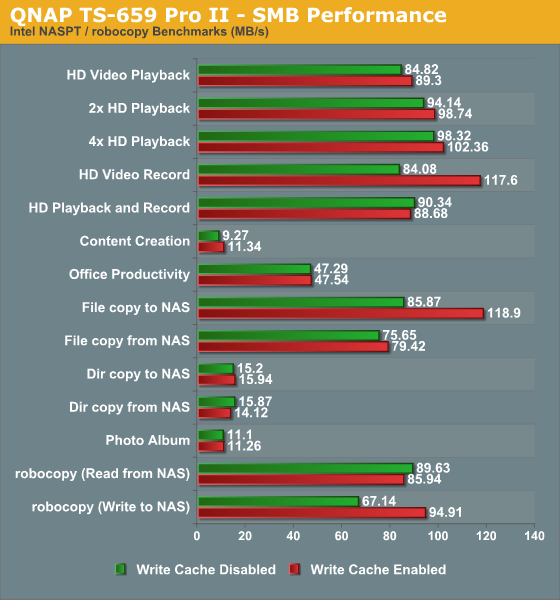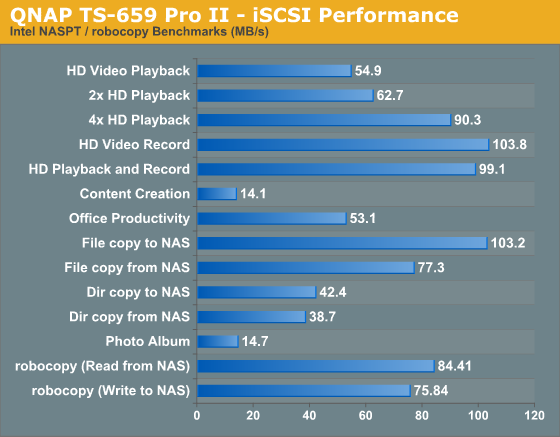QNAP TS-659 Pro II Review
by Ganesh T S on September 19, 2011 8:00 AM EST- Posted in
- IT Computing
- NAS
- QNAP
Samba shares can be set up easily by enabling the Microsoft Networking service. Under Access Rights Management, any of the folders in the NAS can be included in the 'Share Folders' section. Running the Intel NASPT benchmark and the robocopy tests gave us the following results:

Note that we have also run the benchmarks with the write cache enabled. This shows more than 35% improvement in the write intensive workloads, but the usual expected performance improvement is between 10 to 20% in general use. Unfortunately, it is recommended that the write cache be turned off for virtualized environments.
Moving on to iSCSI, it is again quite straightforward to enable the iSCSI service in the Disk Management's iSCSI subsection. The Target Management tab has a Quick Configuration Wizard to help create an iSCSI target and LUN.

In addition to the NASPT benchmarks for iSCSI, we also put the target through the HD Tune Pro benchmarks. The gallery below presents the various metrics of interest.
In order to test out NFS performance, we set up port trunking with 802.3ad for the ESA I340 in Ubuntu 11.04. rsync was used to replicate the robocopy command of transferring a 10.7 GB Blu-ray folder structure to the NAS and back from it.
| TS-659 Pro II NFS Performance in Ubuntu 11.04 | |
| Write to NAS | 67.83 MBps |
| Read from NAS | 61.30 MBps |
| . | |
















69 Comments
View All Comments
meesterlars - Tuesday, September 20, 2011 - link
Sorry, Ganesh, I must have not seen that you had written the review.Yes, please do try and recreate the issues documented in the forum. Perhaps a little publicity from you guys would pressure QNAP into action.
IaninKL - Friday, May 25, 2012 - link
Hi Ganesh,I've just bought a TS-559Pro-II, so far just using it for a short-term project so have configured as JBOD and loaded about 6TB of data. 5*2TB Enterprise-grade drives.
I am wondering if the issue raised here was ever resolved?
The linked-page on the QNAP Forums has been taken down and there is no follow-up info on this thread either.
Cheers - keep up the great work!
QNAPSimon - Friday, September 23, 2011 - link
Thanks for bring this to our attention. We at QNAP are aware of the problem and have allocated dedicated resources to look into this. I will follow up on this and provide updates on our forum. If you have related concerns please email me.simonchang@qnap.com
Thanks
Hrel - Tuesday, September 20, 2011 - link
Quick search found 940 online. No hard drives inluded. Bahaha, no.MobiusStrip - Wednesday, September 21, 2011 - link
That's just ridiculous. There's no reason you should have to put drives in sleds. They should go in like cartridges, with a simple Eject button to remove them. Like these toaster-style drive docks:http://www.newertech.com/products/hdddocks.php
If locks are all that important, the lock could be above each slot and simply move a bar down to lock the drive in.
ZPrime - Friday, September 23, 2011 - link
In many systems, caddies help with noise isolation. I have several HP Home Servers and the caddies are plastic, but they have silicone/rubber grommets around a metal peg that attaches to the drives. They are tool-less, FWIW.Caddies can also help insure proper grounding. Depending on your chassis composition (some are plastic or have plastic rails), you might need some other way to get the body of the drive to ground to the chassis. Plastic caddy + metal inserts that connect to a metal latch or similar can solve this problem.
ZPrime - Wednesday, September 21, 2011 - link
Just because you have an LACP bonded connection between two machines does *NOT* mean that transfers will take full advantage of this. When you were testing for performance, did you run multiple simultaneous transfers?LACP / 802.3ad load balancing isn't as simple as people think. Bonding a pair of 1GB NICs doesn't give you "2GB of bandwidth."
Nenad - Friday, September 23, 2011 - link
In short: iSCSI >> SMB for small files and when file-cache can be usedI have QNAP TS-459 Pro+ and QNAP TS-419P , and I use them both with SMB and iSCSI.
In your test, performance of iSCSI is similar to SMB, even with write cache disabled in most parts.
But in my practice I find iSCSI has noticeably better performance in many cases, especially when you work with many small files. That can be seen on your test in 'DIR copy', but as just one number among dozen other it does not stand out. Unfortunately, it is mostly DIR copy where you need or notice speeds - copying single file will usually end fast regardless of SMB/iSCSI, video playback needs much smaller bandwith anyway etc ... it is copy of large folders with subfolders you need (and notice) speed.
Another area where iSCSI seems to have advantage is with using file-cache on windows. I'm not precisely certain how that works, but it appears that windows do not use caches so efficiently for networked/remote disk, as it does for 'local' iSCSI disk.
One practical application of this is anti-virus scanners, who tend to scan 'other' disk when you copy files - resulting in almost double time needed to copy file to/from QNAP, since for example first Norton read file from SMB share to scan, and then allows Windows to copy it locally. With iSCSI I see much smaller impact , and I believe that while Norton probably work same with reading file to scan, Windows can better use file cache to skip another reading when it needs to copy.
Carlu - Monday, October 3, 2011 - link
I love this small boxes, good power-performance ratio, but it sux when it comes to fulldisk crypto. nether the CPU has any good support for it, nor does it handles harddrives with inbuilt disk crypto. And for the same amount of money you get a 20W Xeon 20L, and a micro atx motherboard/chassi etc... and the Xeon has support for AES-IN instruction set...